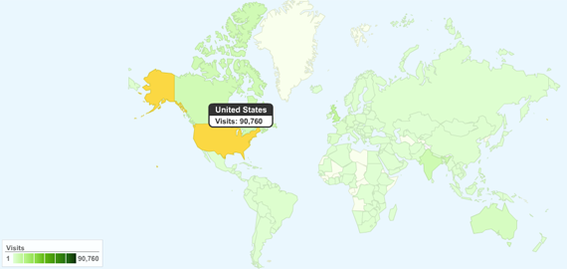Understanding your customers — including their preferences and opinions — is an important part of ecommerce marketing. One helpful indicator of customer behavior is location, because where one lives can have a profound effect on what one buys and how one shops.
Urbanites living in downtown San Francisco, California might have very different needs than a person living in rural Oklahoma, even when they are visiting the same online store.
Google Analytics offers very detailed location-specific demographic information about site visitors. This creates opportunities for marketers to better understand customers and, perhaps, make improvements to site content, merchandising, and advertising. Even social media marketing efforts may be improved with location data.
Discovering Location Data in Google Analytics
To access Google Analytics map and location features login to your Analytics account and navigate to “Visitors” and then “Map Overlay.” Some newer versions of Google Analytics may say “Demographics” rather than “Map Overlay.”

Find “Map Overlay” under “Visitors” in Google Analytic’s left navigation.
By default, the map displays the number of visits for each region of the world for the past 30 days. Hovering over any country on the map displays the total number of visits from the selected country for the specified timeframe.

By default the map shows visit data for the past 30 days by country.
For many ecommerce businesses, national traffic data may not be particularly useful, since many ecommerce businesses don’t sell internationally on a regular basis because of expensive overseas shipping. But if a marketer finds a significant amount of traffic from unexpected locations, it may be an indication that the store should consider targeting that location. For example, some online retailers of cowboy hats and boots have discovered a market for their products in Japan using this kind of data.
Clicking a country in the Google Analytics map overlay zooms into a nation’s regions. The beta version of Analytics does this for all nations, while stable versions offer a state view for the United States. This data can be useful to ecommerce marketers.

Analytics will also divide nations into sub-regions like states.
Knowing what state customers are coming from can provide marketers with some important information. For example, if most of a site’s visitors are from California, it may be that the store’s marketing has hit on a particular product or search phrase that resonates with Californians. Knowing this may help optimize any number of marketing tactics to appeal even more to this group.
Likewise, if your customer service closes at 5 p.m. Eastern U.S. Time, but most of a store’s site traffic comes from the Pacific Time Zone, it may make sense to stay open later.

Analytics offers data about the specific cities site visitors are coming from.
At the level of individual cities, a marketer can begin to make specific assumptions about shoppers. For example, if a site selling mountaineering gear is seeing lots of traffic from the San Francisco area in California, it may be safe to assume that those shoppers are amateurs planning a vacation. This assumption in turn may mean that posting how-to articles or videos on an ecommerce site might resonate with this audience. By contrast if most of the sites visitors were coming from areas near popular climbing regions, if may be safe to assume that those shoppers are regular mountaineers who might respond better to a different sort of content.
In addition to counting visits, the Map Overlay in Google Analytics displays page per visit, average time on site, the percentage of new visitors, bounce rate, and goal specific conversion data. This additional information is also extremely valuable. To continue with the site content example, some ecommerce marketers may find that they get the most visitors from one region or city, perhaps Albany, New York, but that other regions, say Grand Junction, Colorado, spend longer on the site and bounce at a lower rate. This sort of finding may show that the store is doing a better job of marketing to New Yorkers in external marketing or advertising, but providing content that is more interesting to folks in Colorado. Understanding this relationship may lead to marketing improvements and more sales.
Location Data for Multi-Channel Merchants
Online sellers that also have physical, brick-and-mortar stores may also use Google Analytics geolocation data for advertising or to decide if it makes sense to open new store locations.
Final Analysis
Google Analytics offers some significant location-specific information that ecommerce merchants can use to improve marketing and advertising. Although ecommerce sites can sell anywhere, knowing where shoppers are coming from can certainly help to make better marketing choices.




